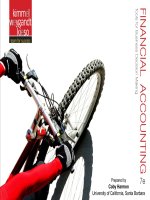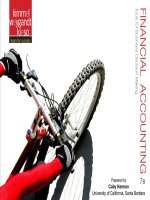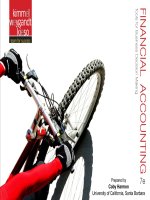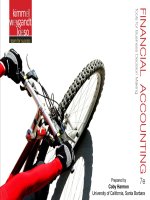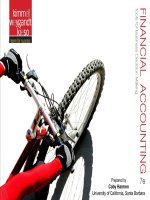Financial Accounting Tools for Business Decision Making chapter 01 introduction to financial statements
Bạn đang xem bản rút gọn của tài liệu. Xem và tải ngay bản đầy đủ của tài liệu tại đây (2.39 MB, 47 trang )
1-1
INTRODUCTION
TO FINANCIAL
STATEMENTS
1-2
Financial Accounting, Seventh Edition
1
Learning
Learning Objectives
Objectives
After studying this chapter, you should be able to:
1-3
1.
Describe the primary forms of business organization.
2.
Identify the users and uses of accounting information.
3.
Explain the three principal types of business activity.
4.
Describe the content and purpose of each of the financial
statements.
5.
Explain the meaning of assets, liabilities, and stockholders’ equity,
and state the basic accounting equation.
6.
Describe the components that supplement the financial statements
in an annual report.
Preview of Chapter 1
Financial Accounting
Seventh Edition
Kimmel Weygandt Kieso
1-4
Forms
Forms of
of Business
Business Organization
Organization
1-5
LO 1 Describe the primary forms of business organization.
In choosing the organizational form for your outdoor guide
service, you should consider the pros and cons of each. Identify each of the following
organizational characteristics with the organizational form or forms with which it is
associated.
1. Easier to raise funds.
2. Simple to establish.
3. No personal legal liability.
4. Tax advantages.
5. Easier to transfer ownership.
Solution
1.
2.
3.
4.
5.
1-6
Corporation.
Sole proprietorship and partnership.
Corporation.
Sole proprietorship and partnership.
Corporation.
LO 1 Describe the primary forms of business organization.
Users
Users and
and Uses
Uses of
of Financial
Financial Information
Information
Internal
Users
Illustration 1-1
Questions that internal
users ask
1-7
LO 2
1-8
Users
Users and
and Uses
Uses of
of Financial
Financial Information
Information
External
Users
1-9
Illustration 1-2
Questions that external
users ask
LO 2
1-10
Users
Users and
and Uses
Uses of
of Financial
Financial Information
Information
Ethics In Financial Reporting
United States regulators and lawmakers were very concerned
that the economy would suffer if investors lost confidence in
corporate accounting because of unethical financial reporting.
1-11
Recent financial scandals include: Enron, WorldCom,
HealthSouth, AIG, and others.
Congress passed Sarbanes-Oxley Act of 2002.
Effective financial reporting depends on sound ethical
behavior.
LO 2 Identify the users and uses of accounting information.
Users
Users and
and Uses
Uses of
of Financial
Financial Information
Information
Illustration 1-3
Steps in analyzing ethics cases
1-12
LO 2 Identify the users and uses of accounting information.
1-13
Users
Users and
and Uses
Uses of
of Financial
Financial Information
Information
Review Question
Which of the following did not result from the SarbanesOxley Act?
a. Top management must now certify the accuracy of
financial information.
b. Penalties for fraudulent activity increased.
c. Independence of auditors increased.
d. Tax rates on corporations increased.
1-14
LO 2 Identify the users and uses of accounting information.
Business
Business Activities
Activities
All businesses are involved in three types of activity —
financing,
investing,
and operating.
The accounting information system keeps track of
the results of each of these business activities.
1-15
LO 3 Explain the three principal types of business activity.
Business
Business Activities
Activities
Financing Activities
Two primary sources of outside funds are:
1. Borrowing money (debt financing)
Amounts owed are called liabilities.
Party to whom amounts are owed are creditors.
Notes payable and bonds payable are different types
of liabilities.
2. Issuing (selling) shares of stock for cash.
1-16
Payments to stockholders are called dividends.
LO 3 Explain the three principal types of business activity.
Business
Business Activities
Activities
Investing Activities
Purchase of resources a company needs to operate.
1-17
Computers, delivery trucks, furniture, buildings, etc.
(property, plant, and equipment).
Resources owned by a business
are called assets.
Investments are another
example of an investing activity.
LO 3 Explain the three principal types of business activity.
Business
Business Activities
Activities
Operating Activities
Once a business has the assets it needs, it can begin its
operations.
1-18
Revenues - Amounts earned from the sale of products
(sales revenue, service revenue, and interest revenue).
Inventory - Goods available for
sale to customers.
Accounts receivable - Right to
receive money from a customer
as the result of a sale.
LO 3
Business
Business Activities
Activities
Operating Activities
1-19
Expenses - cost of assets consumed or services used.
(cost of goods sold, selling, marketing, administrative,
interest, and income taxes expense).
Liabilities arising from expenses include accounts
payable, interest payable, wages payable, sales taxes
payable, and income taxes payable.
Net income – when revenues exceed expenses.
Net loss – when expenses exceed revenues.
LO 3 Explain the three principal types of business activity.
Classify each item as an asset, liability, common stock,
revenue, or expense.
1-20
Solution
1. Cost of renting property.
1. Expense.
2. Truck purchased.
2. Asset.
3. Notes payable.
3. Liabilities.
4. Issuance of ownership shares.
4. Common stock.
5. Amount earned from providing service.
5. Revenue.
6. Amounts owed to suppliers.
6. Liabilities.
LO 3 Explain the three principal types of business activity.
Communicating
Communicating with
with Users
Users
Companies
Companiesprepare
preparefour
fourfinancial
financialstatements
statementsfrom
fromthe
the
summarized
summarizedaccounting
accountingdata:
data:
Income
Statement
Retained
Earnings
Statement
Balance
Sheet
Statement
of Cash
Flows
International Note The primary types of financial statements required by International
Financial Reporting Standards (IFRS) and U.S. generally accepted accounting
principles (GAAP) are the same.
1-21
LO 4 Describe the content and purpose of each of the financial statements.
Communicating
Communicating with
with Users
Users
Review Question
Net income will result during a time period when:
1-22
a.
assets exceed liabilities.
b.
assets exceed revenues.
c.
expenses exceed revenues.
d.
revenues exceed expenses.
LO 4 Describe the content and purpose of each of the financial statements.
Communicating
Communicating with
with Users
Users
Income Statement
Reports revenues and
expenses for a specific
period of time.
Net income – revenues
exceed expenses.
Net loss – expenses
exceed revenues.
Past net income provides
information for
predicting future net
income.
Illustration 1-4
Helpful Hint The financial statement heading identifies the company, the type of
1-23
statement, and the time period covered. Sometimes, another line indicates the unit of
measure, e.g., “in thousands” or “in millions.”
LO 4
Communicating
Communicating with
with Users
Users
Income Statement
Illustration 1-4
Retained Earnings
Statement
Illustration 1-5
Net income is needed to
determine the ending balance in
retained earnings.
1-24
LO 4 Describe the content and purpose of each of the financial statements.
Communicating
Communicating with
with Users
Users
Statement shows amounts and
causes of changes in retained
earnings during the period.
Time period is the same as
that covered by the income
statement.
Users can evaluate dividend
payment practices.
Retained Earnings
Statement
Illustration 1-5
Helpful Hint The heading of this
statement identifies the company, the
type of statement, and the time period
covered by the statement.
1-25
LO 4 Describe the content and purpose of each of the financial statements.
